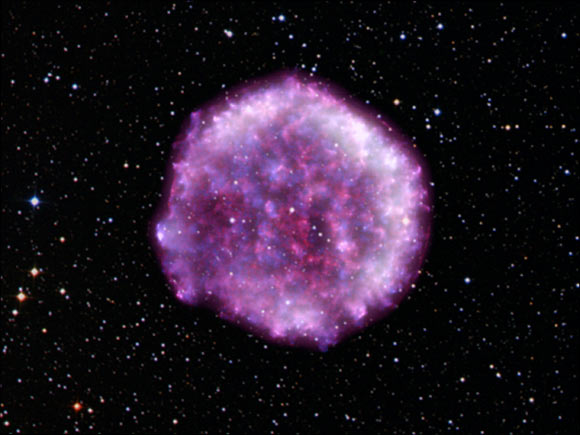Astronomers using the Imaging X-ray Polarimetry Explorer (IXPE) — a collaboration between NASA and the Italian Space Agency — have observed X-ray emitting regions of Tycho’s supernova remnant (SNR) — the remnant of the historical supernova SN 1572, first recorded in November of that year and named after the Danish astronomer Tycho Brahe.

This image shows Tycho’s SNR, which is located between 8,000 and 10,000 light-years away in the constellation of Cassiopeia. IXPE data (dark purple and white) have been combined with data from NASA’s Chandra X-ray Observatory (red and blue) and overlaid with the stars in the field of view as captured by the Digitized Sky Survey. Image credit: IXPE / NASA / ASI / MSFC / INAF / Ferrazzoli et al. / Chandra / CXC / RIKEN / GSFC / Sato et al. / DSS / SAO / K. Arcand, L. Frattare & N. Wolk.
SN 1572, also known as the Tycho’s supernova or Tycho’s Nova, was discovered by Tycho Brahe in November 1572.
Modern astronomers know that the event was a Type Ia supernova, caused by the explosion of a white dwarf star.
The explosion spewed elements like silicon and iron into space at speeds of more than 5,000 km/s.
As with many supernova remnants, Tycho’s SNR glows brightly in X-ray light because shock waves generated by the explosion heat the debris up to millions of degrees.
In the new study, Dr. Riccardo Ferrazzoli from the Italian National Institute for Astrophysics and colleagues used IXPE to study polarized X-rays from Tycho’s SNR.
IXPE revealed, for the first time, the geometry of the magnetic fields close to the shock wave, which is still propagating from the initial explosion and forms a boundary around the ejected material.
Understanding the magnetic field geometry allows the scientists to further investigate how particles are accelerated there.
“As one of the so-called historical supernovae, Tycho was observed by humanity in the past, and had a lasting social and even artistic impact,” Dr. Ferrazzoli said.
“It’s exciting to be here, 450 years after its first appearance in the sky, to see this object again with new eyes and to learn from it.”
Measuring X-ray polarization tells astronomers the average direction and ordering of the magnetic field of light waves that make up X-rays from a high-energy source like Tycho’s SNR.
“The process by which a supernova remnant becomes a giant particle accelerator involves a delicate dance between order and chaos,” said Dr. Patrick Slane, a senior astrophysicist at the Harvard & Smithsonian’s Center for Astrophysics.
“Strong and turbulent magnetic fields are required, but IXPE is showing us that there is a large-scale uniformity, or coherence, involved as well, extending right down to the sites where the acceleration is taking place.”
Although previous observatories have looked at Tycho’s SNR’s magnetic field in radio waves, IXPE measured the shape of the field on scales smaller than one parsec, or roughly 3.26 light-years, but the closest researchers have ever come to observing the source of the highly energetic cosmic rays emitted by one of these distant phenomena.
This information is valuable as scientists explore how particles are accelerated in the wake of the initial explosion’s blast wave.
The researchers also documented similarities and surprising differences between IXPE’s findings at Tycho and at the Cassiopeia A supernova remnant, an earlier subject of study.
“The overall directions of the magnetic fields in both supernova remnants appears to be radial, stretched out along a direction extending outward,” they said.
“But Tycho’s SNR yielded a much higher degree of X-ray polarization than Cassiopeia A, suggesting it may possess a more ordered, less turbulent magnetic field.”
The findings will appear in the Astrophysical Journal.
_____
Riccardo Ferrazzoli et al. 2023. X-ray polarimetry reveals the magnetic field topology on sub-parsec scales in Tycho’s supernova remnant. ApJ, in press; arXiv: 2301.07397







